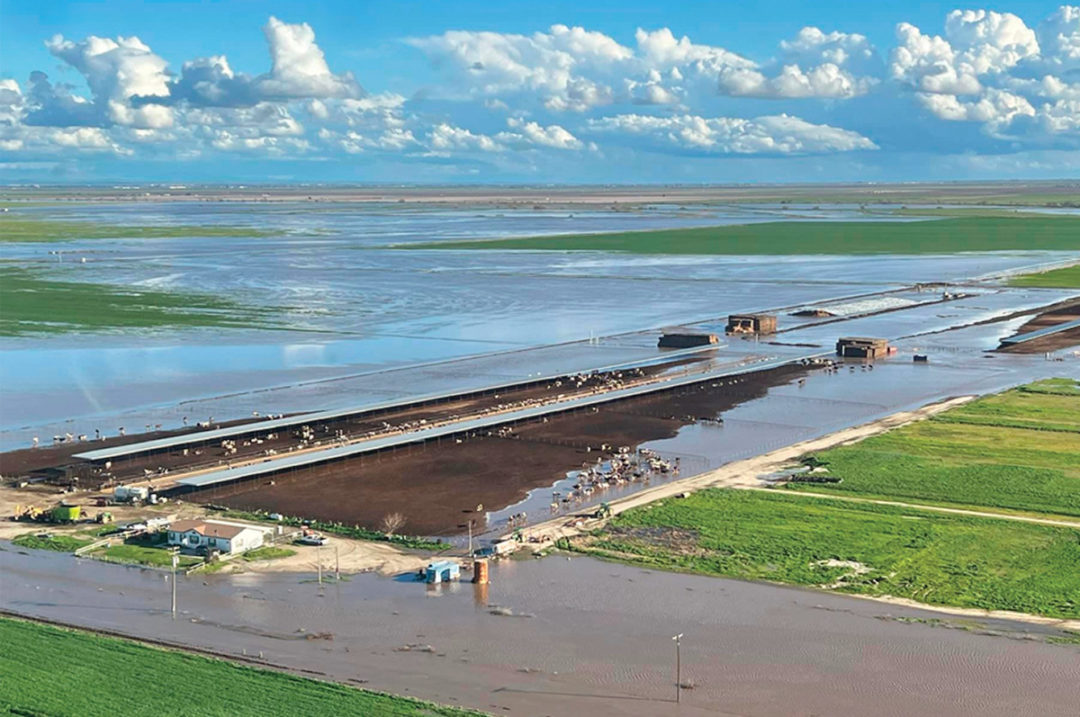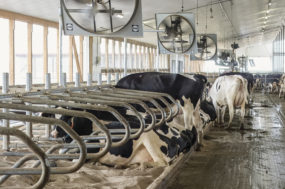Over the course of the past month, and likely for the next several years, California dairy farmers are having to make drastic adjustments to their operations. This is due to unprecedented floods that devastated much of California’s Central Valley as well as several coastal areas of the state.
Last winter resulted in the most rainfall and snowpack California has seen in decades. This appeared as a positive sign to agriculturalists in the Golden State, as this water could aid with the state’s historical drought problem. However, a lack of supportive infrastructure for water storage and management proved to be the downfall of the agricultural areas throughout California as the rain and melting snow quickly filled canals, rivers and lakes. The stress from this excessive water on these natural storage systems caused them to fail. On March 14 the Tule River, a prominent body of water running through many of the most agriculturally productive areas in the Central Valley, broke. This allowed water to destroy the roads, fields and dairies of all surrounding areas.
Cropland used to grow dairy feed was left in ruin. Dairy cattle were being hauled to any operations that had room. The families of workers and dairy producers were evacuated from their homes. Roads were destroyed and closed, preventing trucks with trailers, transportation vehicles and evacuating residents to access necessary roads to reach their destinations. Driving through the countryside, the damage was abundantly clear as giant sandbags line the roads, crops lay in ruin, and lakes of water occupy pens that once held heifers.
Tyler Ribeiro is a fourth-generation dairy farmer from Tulare whose family has shared his passion for dairy cattle for over 100 years. He is actively involved in several organizations and groups that support the California dairy industry, and he works tirelessly to support his community and fellow agriculturalists. While Ribeiro was fortunate to not suffer the same catastrophic damage those around him experienced, he was still heavily impacted by the floods.
“I opened the door and it’s my cousins going, ‘Hey, the river broke,’” Ribeiro said. “That was a sound byte that kind of gives me chills now.” He described his mentality as he realized what was to come after hearing the news. He explained that he spent the remainder of March 14 working to help his neighbors escape the floods. He worked into the night aiding those around him as their homes and land were consumed by water. While his property experienced minimal damage, he was just as involved as anyone else.
This instinct to band together was what allowed for the farmers of the Central Valley to survive as well as they did. Many families worked together to preserve animals, equipment and people. Much of the cropland may have been lost, but there were very few animal casualties and what could be preserved often was.
Ribeiro’s concerns are shared by the other farmers of the area. Those being that the damage will have an immense long-term impact on the dairy industry. With much of the feed destroyed and cropland underwater, there wasn’t much hope for the remaining dairy cattle.
“We’ve been planning on growing crops in a drought,” Ribeiro said. “People are really growing what they can and feeding what they have, and now the crop that they’re depending on right now is underwater and there’s a good chance they’re not going to get it.” The concerns of the dairy industry at the moment is with the long-term impacts this water will have on the ability to grow feed. The current crops will not be able to be harvested for an unknown amount of time. It is likely that the next crops planted will not be able to produce the necessary yield to maintain production. There’s a possibility that cropland in the Central Valley will take years to recover to normal conditions.
The Tulare County Farm Bureau has observed this concern and is working to aid the farmers struggling with this reality. Tricia Stever Blattler, the executive director of the Tulare County Farm Bureau, has focused her efforts on working with producers in her area, as well as members of her team, to get relief and support for Central Valley farmers.
“I think we’re going to see this, it’ll be, you know, millions and millions of dollars in recovery aid will be needed in the Central Valley and on the Central Coast,” Stever Blattler said. “Monterey County was hit equally as hard. A lot of our lowest-income, most disadvantaged communities are those where farmworkers live and those were hit really hard by some of these floods.” Stever Blattler explained that it will take an abundance of support to recover from this damage. She also described the ripple effect this will have on other industries that rely on the dairy industry.
Through the support of the Farm Bureau and other organizations, relief and support is being provided to dairy farmers of California. The industry will be suffering new challenges for the next few years as people are selling their operations, feed becomes even more difficult to obtain, and infrastructure begins to be rebuilt.
The combined effort of the agricultural communities in California will ultimately be what helps the dairy industry prevail. These challenges will continue to rise, but people like Ribeiro and Stever Blattler provide hope that the industry can recover from this.





